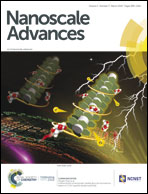Carbon nanotubes–elastomer actuator driven electrothermally by low-voltage†
Abstract
Electroactive polymers (EAPs) have attracted attention in many fields such as robotics, sensors devices and biomedical devices. However, the practical application of these actuators has still problems due to incomplete reversibility and high applied voltage. In order to overcome these problems, in this study, we have shown actuator based on phase transition that is consisted of the carbon nanotubes yarn infiltrated with the mixture of elastomer and methanol. Our electrothermally driven hybrid coiled yarn muscle provides a work capacity of 0.49 kJ kg−1 and a tensile contraction of 30.5% within ∼3 s on an applied stress of 3.1 MPa at an applied DC voltage of 5 V. The maximum work capacity is under isobaric 23.4 MPa, which is 110 times that of typical mammalian skeletal muscles. This actuator may serve as a promising candidate for the practical use in soft robotics.

- This article is part of the themed collections: Nanoscale Advances Most Popular Articles so far and International Year of the Periodic Table : Low Dimensional Carbon Systems


 Please wait while we load your content...
Please wait while we load your content...